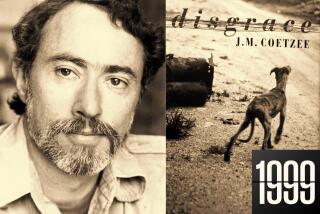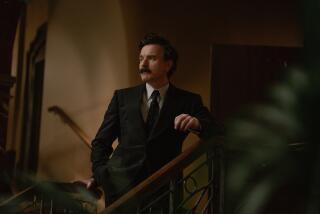Doing Dostoevsky : A father becomes the artist who ‘masters’ facts by reinventing them : THE MASTER OF PETERSBURG, <i> By J. M. Coetzee (Viking: $21.95; 250 pp.)</i>
- Share via
A noted 19th-Century Russian writer, living abroad, returns to Petersburg when he receives word of the mysterious death of his stepson, Pavel. Grief-stricken, he goes through the young man’s trunk, inhaling the odor from his clothes as if to take possession of his ghost.
He whispers “Pavel” repeatedly to himself. He thinks of an Orpheus who walks backward “step by step, whispering the dead woman’s name, coaxing her out of the entrails of hell; of the wife in graveclothes with the blind, dead eyes, following him, holding out limp hands before her like a sleepwalker.”
So, with misleading tenderness, begins J. M. Coetzee’s harsh, cerebral, provocative novel about the savage mechanism of artistic creation. He conceives it as a Darwinian process, a life that crowds out life, a struggle in which a brilliantly specialized organism feeds on its host and destroys it.
Feeding on the memory of Pavel, the father metamorphoses into the writer. Leaching his love is an undercurrent of generational suspicion and resentment. Grieving and guilt-stricken, he is also a child-devouring Saturn. For a while it seems that he will turn Pavel--who had quarreled, left home and joined a circle of nihilist conspirators in Petersburg--into the character of Stavrogin.
The father, of course, is Dostoevsky, Coetzee’s Master of Petersburg. (Stavrogin is the possessed or be-demoned protagonist of the novel that is variously translated as “The Possessed” and “The Demons.”) Coetzee has audaciously taken facts from Dostoevsky’s life and imagined the transformation by which a father, monstrously, becomes the artist who “masters” these facts by reinventing them. It is an operation of love, hatred and art, inextricably mingled.
The book is knotty and sometimes punishingly abstract--it is an idea more than a novel--but at its most powerful the idea burns and terrifies. There are moments when, as in some Pirandello-like variation on Dr. Jekyll and Mr. Hyde, we see the features of a man liquefying into the lineaments of fiction.
Coetzee writes about the tormented Dostoevsky as someone himself possessed by demons, and pulled about in emotional and intellectual spasms (a mimicry of the epileptic seizures that the writer in fact endured). Dostoevsky’s fiction, his life, and Coetzee’s fiction about the life and the fiction: all three are intricately, elegantly and coldly intertwined.
The protagonist shows traces of Raskolnikov in “Crime and Punishment,” of Ivan Karamazov, and even of the epileptic Prince Myshkin in “The Idiot.” He is saintly and corrupt. He lodges with Anna, Pavel’s landlady; a type of a Dostoevskyan fallen and redeeming woman. They make passionate love alternating, on her part, with horror and on his, with a vision of salvation. There is Anna’s innocent yet preternaturally knowing daughter, whom Coetzee’s Dostoevsky has nightmares of corrupting. There is a Buddha-like and unstoppable police investigator, a second Inspector Porfiry.
There is Nechaev, the real-life nihilist conspirator--possibly, in real life, a police agent as well--on whom the character of Verhovensky in “The Possessed” is based. Coetzee’s Nechaev, who draws Pavel into his clandestine net just as Verhovensky drew Stavrogin, is Dostoevsky’s arch-antagonist. They hold a nightlong disputation that suggests the Grand Inquisitor scene in “The Brothers Karamazov.” Here, though, each man slips back and forth between the roles of Inquisitor and Christ, with Dostoevsky getting the last turn at Christ and a chance to plant a damp kiss on Inquisitor Nechaev’s pimply visage. He does not, however, reduce him to silence; quite the opposite.
In “The Possessed,” the Nechaev character is the demon of nihilistic violence that fatally corrupts the malleable Stavrogin. “Master” takes the villain of Dostoevsky the writer, and turns him into the scourge of Dostoevsky the character. A villain still, he gets to answer back.
Nechaev assails his interlocutor for turning his wretched and abused characters into saintly and spiritual beings. As such, they threaten no one; certainly not the ruling classes. In fact, he argues, the earth’s wretched harbor a prodigious violence. The nihilists, with their program of assassination and bombings, will liberate this violence and ultimately establish a reign of peace and justice.
Dostoevsky had accused the Nechaevists of lacking the idealism of earlier conspirators--he himself was one and went to Siberia for it--and of standing for nothing but blood lust and resentment. In fact, toward the end of their disputation, Nechaev is babbling happily about God and his angels dancing together in melodious equality.
With each of its ironic notes reverberating, “Master” moves sinuously and to uncanny effect between the fiction of a character and the fiction of a fiction. Dostoevsky’s grief is no less authentic for its parodic theatricality. Sitting at table with Anna and her daughter, his silent tears are punctuated by an occasional brief howl. He visits Pavel’s grave with them, takes them on an excursion to the country, links Anna’s arm in his own and dreams of starting a new family with her (though he has a wife in Dresden). It is a lovely moment and it does not undermine itself; what does undermine, deliberately, is the cutting away of such moments into scenes of a drastically different texture.
Suddenly, he and the somber Anna are rolling on his bed and tearing lustfully at each other. The next moment she pulls away, accusing him of using her to seduce her daughter. The moment after she is back for more tearing. Bit by bit we sense that we are not in a story but in a succession of story drafts; as if Dostoevsky had imperceptibly changed from the tormented character to the writer who paces the room, acting his pages out and experimenting with changes.
We see him, for example, distilling his resentment of his stepson’s subservience to Nechaev into the intention to write him as the corrupted Stavrogin. In fact--though we have to read “The Possessed” to realize it--he relents and turns Pavel into the more winning character of Shatov, who succumbs momentarily to Verhovensky/Nechaev but dies rebelling against him.
In design, “The Master of Petersburg” is a provocative and ironic exploration of the relation of art and life. In substance, and in many ingenious ways, it is an attempt to write a Dostoevskyan novel about Dostoevsky writing a novel. The design is a tour de force and dryly successful. The substance is engrossing but it falls short.
Even though Coetzee is a master himself, he cannot produce the essential element in re-creating the master of Petersburg. Any of Dostoevsky’s characters, after only a few pages, makes the heart freeze and the eyes weep. Coetzee achieves a measure of freezing; the eyes stay quite dry.
More to Read
Sign up for our Book Club newsletter
Get the latest news, events and more from the Los Angeles Times Book Club, and help us get L.A. reading and talking.
You may occasionally receive promotional content from the Los Angeles Times.







